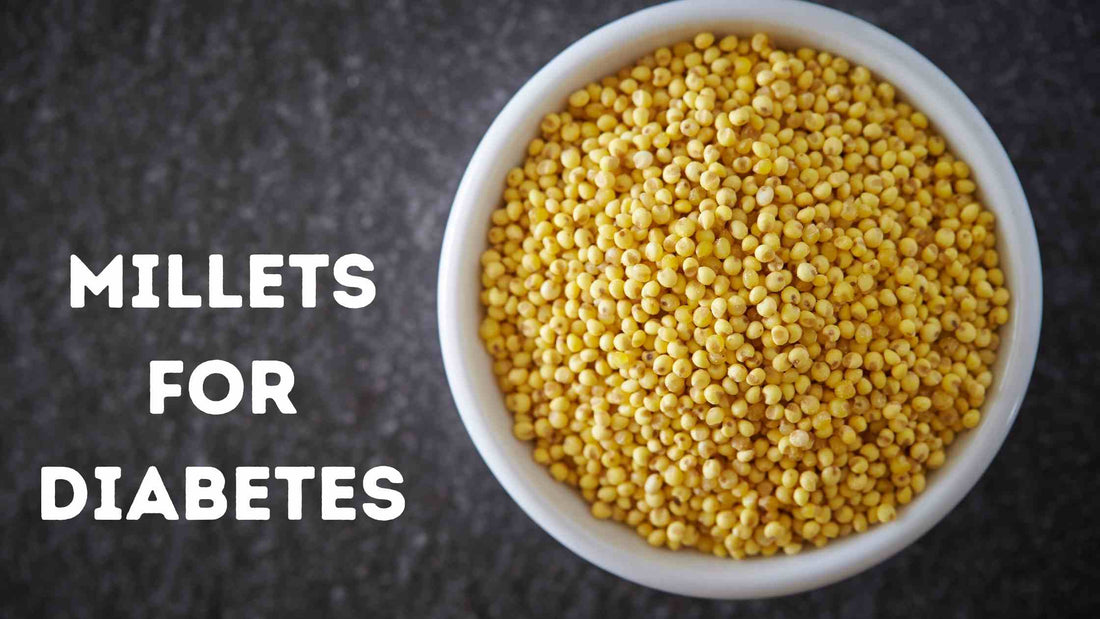
Millets for Diabetes : A Complete Guide
Naturally YoursShare

Millets have enormous health benefits, but have you ever considered including these tiny grains into your diet as a diabetic?
Eating to beat diabetes is about making wise food choices than denial and deprivation.
A better way to reverse diabetes is not about compromising your favourite foods but choosing nutritionally balanced meal plan aimed at maintaining blood sugar levels within range and supporting a healthy weight.
In the current pandemic situation, people are more concerned about their health and eating habits. When it comes to diabetes, they’re curious to understand many terminologies and its importance in blood sugar control.
Let’s learn why millet is beneficial for people with diabetes, as well as how to include them in your routine diet.
Can people with diabetes eat millets?
Obviously Yes!
Millets are high in protein and facilitate insulin sensitivity which, in turn, makes them diabetes friendly grains.
Insulin is the hormone that the body uses to convert carbohydrates into energy. Having millets once in a while won't have much of an impact, but they should be included as part of a regular diet if you want to have long-term success in managing diabetes.
These factors make millets an effective food for controlling blood glucose levels.
How Millets Benefits Diabetes?
Studies performed on people with type 2 diabetes, examined the effect of foxtail millet. One study found that switching from rice to foxtail millet at breakfast lowered blood sugar after meals.
Due to the presence of high fibre content and antioxidants in millets, it reduces insulin spikes gradually and eases digestion for diabetics. Most importantly, grains are the major source of complex carbohydrates which provides satiety thus initiating weight loss and reduces blood sugar spikes.
Moreover, it takes a longer time for the body to metabolise and break down millets due to their low glycemic load. This means that they are absorbed more slowly into the blood stream and requires less insulin.
Research published in August 2019 in the Journal of Food and Nutritional Disorders, concluded that millets may reduce both fasting and post prandial (after meal) blood sugar levels in healthy individuals as well as for type 2 diabetes.
Let’s Understand the Glycemic Index (GI)

The glycemic index (GI) is a ranking of foods based on the digestion of the carbs by their effect on blood glucose levels. The GI measures how quickly the carbohydrates in foods gets converted into glucose and how much specific food increases your blood sugar levels.
Carbohydrates from different foods lead to various blood glucose response, depending on the types of carbs consumed.
Glycemic index of foods helps to fine-tune your carb-counting while planning your meals, thus keeping blood sugar levels under control.
Glycemic Index of Millets:
High GI foods lead to an immediate spike in blood glucose levels while low GI foods get digested slowly to give a sustained glucose release, without causing sudden spikes in the blood sugar levels.
|
Low GI (< 55) |
Moderate GI (55-70) |
|
Kodo and barnyard millets |
Foxtail, little, finger, pearl millets and jowar |
|
Apple, pear, orange |
Pineapple, papaya, mango (depends on ripeness) |
Consumption of millets which has low - moderate GI foods can help in the prevention and management of type 2 diabetes and reduces the associated complications.
- Focus on a balanced diet with measured amounts of low or medium glycemic foods.
- Practice food diary concept and note down the carbohydrate-rich foods you are eating often and try to swap those foods with low or medium GI foods, to maintain the blood sugar level.
Select low GI foods based on your needs and preferences.
Diabetes Sample Menu: -
|
Meal Pattern |
Food Choices |
|
Breakfast |
Ragi dosa (3) with coriander /dhal chutney |
|
Mid-morning |
Roasted pumpkin seeds/ unsalted almonds (fistful) |
|
Lunch |
Cooked foxtail millet (1 katori) with sambhar and vegetable subzi (half katori) |
|
Evening |
Fresh vegetable salad or sprouts bhel |
|
Dinner |
Bajra roti (3) with veg curry/ soy curry + Buttermilk |
The serving sizes depend on the caloric needs of the individual and the choices may vary based on the meal timings and dietary preferences. Consult a qualified dietitian to plan your meals with low glycemic foods to manage diabetes.
How to include millets in daily meal?
There are many ways to incorporate millet into your meals.
- Serve it in the form of porridge for breakfast.
- Swap rice, wheat, sooji with millets in your meals.
- Toss cooked millet with grilled vegetables or fresh salad to make it more nutritious and filling.
- Prepare millet dosa varieties with different chutney accompaniments.
- Consume millet noodles and multigrain pasta instead of maida based ones
How much to consume?
Millets are rich in insoluble fibre which adds bulk to the stools, you must concentrate on portion size too with enough hydration.
The amount of millet to be consumed depends on the sugar level of an individual, gut health sensitivity and the calorie requirements. Consult with dietician to get customized meal plan accordingly.
Here are the best millets for diabetes
- Foxtail Millet – A study concluded that people with type 2 diabetes who consumed a special diet enriched with foxtail millet had lower levels of blood sugar, cholesterol, and triglycerides. Another study found blood sugar levels dropped after eating foxtail millet instead of rice.
- Finger Millet - Raises your blood sugar slowly and gradually rather than sudden spikes. High-fibre, low-GI foods keep blood sugar steady, lower cholesterol, and help you lose weight. Diabetes patients will benefit from these factors.
- Barnyard Millet: A recent study indicated the potential benefits of barnyard millet in the diet therapy of diabetics. It exerted positive impact on blood glucose and serum lipid levels in diabetic and non-diabetic volunteers after the dietary intervention study of 28 days.
- Finger Millet : The polyphenols of finger millets were found to be major antidiabetic and antioxidant components. Finger millet based diets have shown lower glycemic response due to high fiber content and also alpha amylase inhibition properties which are known to reduce starch digestibility and absorption
- Pearl Millet : Pearl millets are known to increase insulin sensitivity and lower the level of triglycerides. It is also very effective for controlling diabetes because of its high fiber content. It gets digested slowly and releases glucose into the blood at a slower rate as compared to other foods. This effectively helps in maintaining the blood sugar level constant in diabetes patients for a long period of time.
Millets Vs Conventional grains
The main difference lies in their insoluble fibre and nutritional content.
Millet is high in phosphorus, magnesium, calcium and among them finger millet is the most calcium rich source among other cereals.
They are healthier version when compared to rice/wheat because of its high dietary fibre, essential vitamins and mineral content required for the body. Therefore, aid in better digestion and have a nutritional value similar to that of fruits and vegetables.
Nutritionally, the energy value, protein and macro nutrient contents of millets is comparable and sometimes higher than conventional cereals. Research has shown that millets' phenolic properties have high antioxidant activity.
The presence of phytochemicals in millet grains has positive effect on human health by lowering the cholesterol and phytates in the body. Including more millets in the diet may improve health and decrease the risks of diseases when compared to rice.
Millets are not only rich in fibre but also protein. Rice, on the other hand, has a very minimal amount of protein content (3%) and is rich in carbohydrates. Therefore, millets are a healthier option when compared to major cereal grains.
Diabetes Friendly Recipes
The following recipes will introduce you to millet if you've never tried it before;
Foxtail Millet Pongal: -

Ingredients:
- Foxtail millet – 1 cup
- Moong dal split – half cup
- Green chillies – 2 no.
- Pepper and cumin seeds (crushed) – 2 tsp
- Curry leaves – few
- Oil – 1 tsp
- Salt to taste
Serves: 2 persons
Method of Preparation:
1. Measure 1 cup of millet and 1/2 cup of split yellow moong dal.
2. Soak the millet and dal in water for 10 minutes. Add four cups of water to the mixture.
3. Cook in a pressure cooker for 5 whistles (13-15 minutes on medium flame).
4. Now, temper the cooked millet in tsp of oil with green chillies, curry leaves, crushed pepper and cumin seeds. Add salt accordingly.
Mix well the mixture to blend with tempering.
Foxtail millet Pongal is ready to serve.
Pearl Millet Idli: -

Photo courtesy : https://www.chitrasfoodbook.com/2017/10/kambu-idli-dosaipearl-millet-idli-bajra.html
Ingredients:
Pearl millet – 1 cup
Urad dal – ¼ cup
Rice flakes – 2 tbsp
Salt
Serves: 10 idlis
Method of Preparation:
1. In separate bowls, soak the pearl millet in water for 4 hours, whereas urad dal and rice flakes for ½ hour.
2. Then, grind them separately and combine together in a container with necessary salt.
3. The fermentation process will take about 6-7 hours. After fermentation, pour the batter into the plates and steam it for 10 minutes.
4. Pearl millet idlis are ready to serve with coriander/tomato chutney.
Grainy Glimpse!
Due to its superior nutritional qualities, millets have moved from being the ‘poor main’s grain’ to being considered a ‘nutritious grain’. They can serve as an alternative to the conventional grains and help in maintaining healthy blood sugar levels in diabetics.
Trending Articles
1) How to use millets for weight loss - Read Now
2) Kodo millet - Nutrition, benefits and recipes - Read Now
3) Morning habits to help you lose weight - Read Now
ABOUT THE AUTHOR

Indu Vaishnavi R, Dietician



